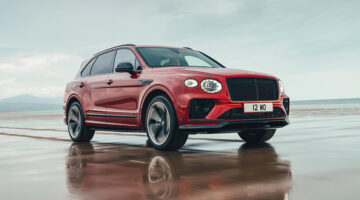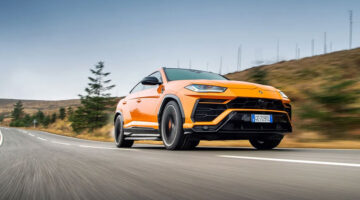| Excellent, well-sorted controls, thoughtful interior gadgets, compact dimensions | |
| Fun factor is absent, similar SEAT Ateca is more affordable |
The Skoda Karoq might not seem like it has much of a place on the website, normally a haven for driving thrills and a celebration of some of the most hardcore supercars. As a small SUV with nothing more potent available under the bonnet than a 2-litre diesel, we can certainly understand why you might be dismayed to see it here.
But that disregards the Karoq’s predecessor completely, because nine years ago Skoda released the rather brilliant Yeti. It might have been a quirky-looking, tall-riding, van-shaped creation, but its robust chassis made it feel undefeatable no matter how awful the road surface, yet there was masses of enthusiasm and spirit when you aimed it at a corner. It may not have had hot hatch-rivalling levels of excitement, even with its most powerful 1.8-litre turbocharged engine, but it was just as involving and as satisfying to pedal along at pace. The Yeti was a truly wonderful surprise to anyone who drove one.
The new Karoq has a lot to live up to, then. Sadly, its more conventional-SUV looks are matched by more conventional-SUV driving dynamics. It’s respectable, definitely. Very composed, undoubtedly. There’s a solidity and precision to its controls that are enjoyable, certainly. Yet its grip-over-fun chassis set-up means it isn’t as magical as the old car, the Karoq feels numb by comparison.
That’s not to say it’s without merit though, and the new Karoq remains one of the better cars in this class both as an ownership proposition and dynamically. It’s certainly a decent basis for the rumoured Karoq vRS, which should bring back a little of the spark missing from the regular model – though for matching practicality with entertainment, Skoda’s own Octavia vRS estate remains our pick at the Karoq’s price point.

Skoda Karoq in detail
Performance and 0-60 time – Depending on which engine is fitted to the Karoq its 0-100kph acceleration time ranges from a tepid 10.9sec to an adequate 8.4sec.
Engine and gearbox – The Karoq’s selection of engines isn’t especially exiting; they’re all turbocharged, but you do get a choice of three- or four-cylinder motors and either petrol or diesel.
Ride and handling – Satisfying controls and sufficient grip make the Karoq sufficiently pleasing to drive, but it’s never particularly exciting no matter how hard you try.
L/100km and running costs – With official combined litre per 100 kilometres figures that don’t drop below 5.6L/100km, no matter what engine is fitted to it, the Karoq has the potential to be very cheap to fill.
Interior and tech – Solid and tough-feeling, with plenty of thoughtful touches to make any task you’d usually undertake in a car just that little bit easier.
Design – It’s small and compact, and it looks it. It’s particularly handsome on chunky 19-inch wheels, too. It’s not excessively heavy either, though 4×4 models are a bit porky.

Prices, specs and rivals
The Skoda Karoq is available from $27,600 for the 1.0 TSI SE, but it can be specced up to over $47,000 if you opt for the 2-litre diesel engine with four-wheel drive and almost every option available. Most models are front-wheel drive, and you’ll need to spend $34,150 to get into the most affordable 4×4 model, fitted with the 2.0 TDI engine and SE trim.
If you’re not in the slightest bit excited by the Karoq, none of its immediate rivals are going to get your juices flowing either. The SEAT Ateca is its closest competition; not only is it based on the exact same platform as the Karoq, it’s also available with all the same engines. However, in what seems like a mistake on behalf of the Volkswagen Group, the cooler Latin SEAT with its sportier, sexier image is cheaper than the budget Czech Skoda as it’s available from $24,700. At its peak Ateca pricing rises above and beyond the $43,000 mark.
The Volkswagen Tiguan, like the Ateca, shares the same basic platform as the Karoq, but the VW’s wheelbase is 39mm longer than its two not-so-distant siblings. Because of its extra space and more premium badge, the Tiguan is a little more expensive, too, starting at $31,000.
But in actual fact, the real thorns in the Karoq’s side – as well as in the flanks of all of its other SUV rivals, as far as we’re concerned – are conventional hatchbacks or small estates. Not only is a regular Ford Focus, Volkswagen Golf, Skoda Octavia or SEAT Leon just as practical (or more if you opt for the estate versions) they’re better to drive thanks in part to their much lower centre of gravity. They’re also much cheaper as a rule, so you could either save yourself some money or spend the extra cash on the more exciting performance versions, the ST, GTI, vRS or Cupra, respectively.
Performance and 0-60 time
The Karoq doesn’t exist to smash acceleration records, set your hair on fire or sit in the outside lane of an Autobahn flashing its lights to encourage RS6s to get out of its way. As a result the double-figures 10.9sec 0-100kph time of the 1.6 diesel version, the slowest accelerating Karoq of the range, is no surprise, but nor should it really come as a disappointment.
Engine and gearbox
The choice of engines in the Karoq isn’t vast; there are two diesel and two petrol motors to choose from. However, despite this quartet you only need remember two peak power outputs, since the smallest capacity petrol and diesel engines put out the same bhp while the larger units match on output too.
Ride and handling
Right from the very start, and after just a few metres down the road, the Karoq appears to be a very satisfying car to meander about in; all of its controls are so tight, so precise and are so completely slack free. All of the pedals are solid and the movement so smooth that just releasing the clutch feels like a rewarding action and the steering – although very light – is amazingly direct. The steering can be made heavier by engaging the Sport driving mode – that’s pretty much all the button does though, as the engine’s character remains the same, there’s no extra noise and, as the dampers are passive, the chassis doesn’t change. The extra weight doesn’t feel appropriate; the more delicate setting suits the other controls in the car.
evo comment
‘This focus on comfort doesn’t come at the expense of agility, and the Karoq can be hustled effectively through a series of corners. The electrically assisted steering is direct and naturally weighted, while there’s decent grip at the front end. The combination of high ride height, modest rubber and, in the diesel models, hefty engines means the nose will wash wide when pushed, but you do have to provoke this behaviour with aggressive inputs.
L/100km and running costs
There isn’t a Karoq available whose combined L/100km figure is below 5.6L/100km; the 1.5-litre petrol version with the DSG transmission just about sneaks above with 5.6L/100km. That’s even with the 1.5 having Active Cylinder Deactivation (ACT), which effectively allows the Karoq to run on two cylinders during light throttle applications, helping to cut fuel use.
The Karoq’s relatively low consumption is reflected in relatively low CO2 figures which in turn mean palatable VED costs. 1.0 TSIs manage 119g/km, manual 1.5 TSIs are 123g/km, 1.6 TDIs come in at 120g/km, and the 4×4 2.0 TDI with the manual gearbox has a CO2 figure of 131g/km. That means, respectively, VED bills of $218 in year one and $185 thereafter for the first three cars, and $270 in first-year VED for the 2.0 TDI and $185 thereafter.
Interior and tech
In typical Skoda form the Karoq is stuffed to the gunwales with useful pockets, holders, cubbyholes and gadgets to make any task that you might perform in the car, other than driving, as easy as possible. There’s a clip on the windscreen to hold parking tickets, a removable torch in the boot and an umbrella under the rear seats as standard.
Design
The Karoq is a fine looking car. It’s relatively compact, and its proportions, thanks to short overhangs, are well balanced. Its details are chunky and purposeful too, yet they’re subtle enough that the Karoq doesn’t have an overt and inappropriate sense of adventure about its styling.









